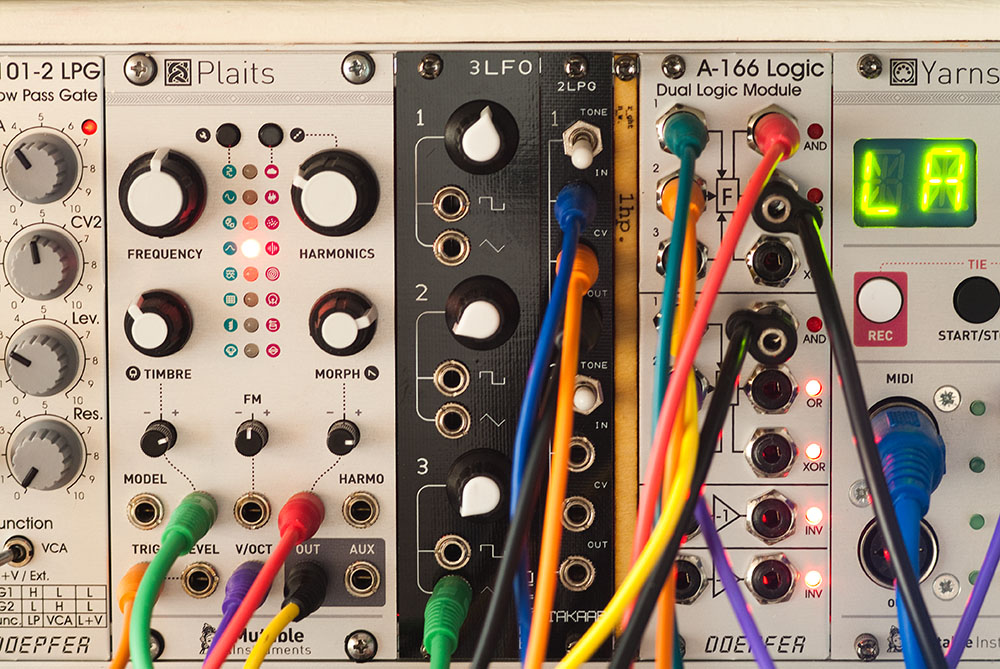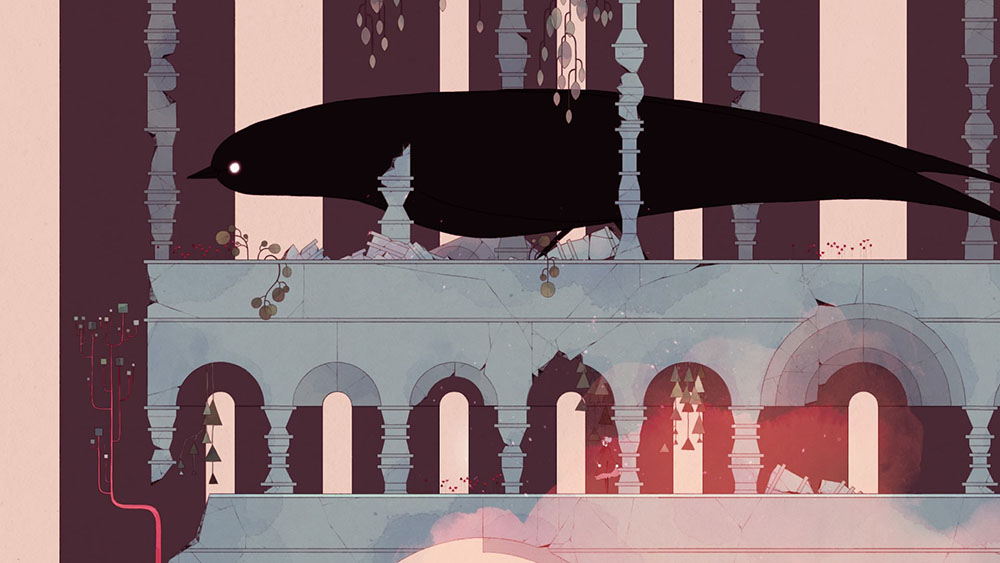I pride myself on staying up-to-the-minute, so in honour of President Nixon's
recent trip to China let's have a look at Gris (2018), a platform
game for almost every modern gaming system except, curiously, the Xbox. As of
this writing it's out on budget. I played it on the PlayStation 4.
Is Gris the time, the place, the motion? Is it the way we are
feeling? Does it have a groove? Does it have a meaning? Does it give me
chills? Are they multiplying? Does it make me lose control? Is it
electrifying? Read on, dear reader, and be thankful that all of the
Grease references are in the first two paragraphs because
otherwise I would have had to weave them into the body text and it would have
taken ages and you wouldn't be reading this until June.
What is Gris? It's a platform game with lovely music. It attracted
good-but-not-great reviews when it came out and went on to sell over a million
copies, which is impressive for a low-key art game without much marketing
behind it. The reviewers compared it to Journey, but it actually
has much more in common with the 2014 platformer Ori and the Blind Forest. They have similar mechanics and progression, and in both games you are
menaced by a bird, although in Gris the bird is a manifestation of
self-doubt whereas in Ori the bird is, from what I remember, an
actual bird:
Ori and the Blind Forest - it resembles a Roger Dean painting.

Gris owes something to Aubrey Beardsley, but it does have floating
rocks, which was a Roger Dean thing as well.
One thing that separates the two games is the difficulty level.
Ori looks cute, but underneath the pleasant exterior it's
surprisingly hard, almost sadistic. Last year's Ori and the Will of the Wisps is apparently even more difficult. On a personal level I enjoyed
Blind Forest but it was a frustrating experience. Periods of
platforming brilliance alternated with frustrating wall-jumping puzzles that
just left me feeling drained and annoyed when I finished them instead of
happy.
I grew up with Jet Set Willy and Head Over Heels, so I'm
used to frustrating gameplay. I didn't enjoy it in the 1980s and I don't enjoy
it now. I played those games because there was nothing better,
although Head Over Heels was more sophisticated than most. In
my opinion the designers of Ori should have made the main story
easier and reserved the really hard jumps for secrets, but what do I know? It
sold millions and lots of people enjoyed it.
In contrast Gris is mellow. You can't die, and there are only two
or three head-scratching puzzles and difficult jumps. The absolute worst that
can happen is that you mess up a jump and have to retrace your steps a little
bit. The developers wanted to make a mood piece, introspective and sad,
although surprisingly there is an actual game underneath the lovely graphics.
Gris tells the tale of a young girl - her name is Spanish for
"grey" - who is trying to cope with an unspecified personal loss, strongly
suggested to be the death of her mother. At first she can only walk slowly
through a landscape of broken statuary, but over the course of the game she
learns how to jump, swim, sing, and turn herself into a solid weight. Not
necessarily in that order. There's no dialogue, there are no subtitles,
there's no story in a conventional sense, just a pervasive sense of loss and
fragility.
She also makes friends with a cute little stone cube who eats apples. He jumps
when you jump, and there are a couple of puzzles where you have to synchronise
your actions in order to proceed:
The game has a simple hub design albeit that you can only replay maps after
you've finished the main story. In each level you have to find a couple of
sparkling stars that form a constellation; optionally you can hunt for memory
fragments that unlock a special cutscene at the end. During the platforming
sequences Gris only has a few powers, but the game mixes things up so that it
never gets boring. In particular there's a late-game section in which Gris has
to carefully leap out of some water blocks without crossing a gravitational
line that gets particularly tricky.
Multiplayer? No. The PlayStation 4 version runs at 1920x1080 but the PC
version runs at any arbitrarily high resolution. Ultra-widescreen support
requires editing a .dll with a hex editor but is otherwise unproblematic.
Gris has some flaws. On the positive side I was pleasantly
surprised that it's an actual
game rather than an interactive
music video. Based on the trailers I was expecting
Gris to be an
elaborate Flash animation in which you walked to the right and occasionally
slid down some hills while the sun rises in the background - the most obvious
nod to
Journey - but it's a proper hub-based multi-level platform
game. It could have gone on longer and I wouldn't have minded. It's more of a
game than e.g.
Far: Lone Sails and far more of a game than visual demos such
as
Proteus or
Linger in Shadows. It even has a
certain amount of reply value, if you want to collect all the memories.
On the negative side Gris has a habit of introducing some
interesting ideas and then quickly abandoning them. The section with the
little forest guy could have gone on longer, but almost immediately after
solving a couple of puzzles he runs off and the game never repeats the
experiment. A section with platforms that appear and disappear as you jump
only amounts to a couple of screens and isn't complex enough to be challenging
because the platforms never go out of sync, so once you work out the route you
can't fail. The game launched at around £15.99; any more would have been too
ambitious for something so slight. Perhaps the team didn't want to overstay
their welcome.
Of note the game is only available digitally. It takes up around 4gb of hard
drive space. There were short-run physical editions by Special Reserve
(Nintendo Switch, with an artbook) and Limited Run Games (PS4), but they have
long since sold out.
Other problems? If you're really old you might remember
Amiga Power and its dislike of slippy-slidey ice worlds, because
they were a cliché of 1990s platform game design. Slippy-slidey ice worlds,
and power-ups that reversed your controls. Gris is guilty on both
counts. Technically it has a scrabbly-wabbly desert world scoured by
irresistible winds, but the end result is much the same. On the other hand the
scrabbly-wabbly desert world is just one short sequence and the antigravity
section only reverses your controls vertically, so it's not onerous.
Good stuff? The music is excellent. It's lighter and less symphonic than for
example Journey, with a hazy, melancholic air. The hub level in
particular would be a fantastic audiovisual screensaver if you were spending a
week binging on tranquilisers. Parts of the music reminded me of Hiroshi
Yoshimura's Nine Post Cards but with lusher orchestration.
And on a visual level the game is of course striking, with a stark, clean
style that gradually fades from grey to multi-colours.
It also occasionally put me in mind of 8-bit platform games. The following
screen in particular made me think of Mikro-Gen's Frost-Byte:
It has been a long time since I thought of Mikro-Gen. The ZX Spectrum was
popular in Spain so, who knows, perhaps the developers really did intend for
parts of the game to pay homage to Starquake et al.
Of course a good game is more than just a bunch of sounds and graphics. For
all its faults as a game Far: Lone Sails stood out because it
had a mood and told a story. Gris is like that. After learning how
to jump and fly Gris seems to be on the mend, but she is menaced by a giant
bird - and then a giant eel - which is presumably a manifestation of her
depression. I don't want to spoil the ending but she does eventually overcome
this, although the grand finale is bitter-sweet. I felt sad at the end and
wished Gris luck for her struggles in the future.
The ending unlocks a gallery of concept art plus some unused musical
tracks.
Some people will probably detest the twee graphic style, the pretty music, the
prissy art design and inoffensive theme etc, but on the whole I'm impressed
with not just Gris but the art game movement in general; it must
have been tempting to churn out cynical imitations of Journey but
the likes of Bound and What Remains of Edith Finch are
clever and surprisingly iconoclastic. Gris straddles an odd
half-way ground, both an art piece and a decent albeit simplistic platform
game, although it's more of the latter than the former.
Nomada Studios was formed purely to develop Gris, and to date it's
their only product. There's no world on a sequel. My hunch is that
they're in an awkward position; they can't repeat Gris' storyline,
so a sequel would have to be a fully-fledged 8-12-hour game along the
lines of Will of the Wisps, but that would require a much higher budget
and a longer development cycle, and realistically what kind of market is there
for Gris 2?
Still, I'm digressing. I finished Gris in three brief
sittings over three days but at £5.98 I didn't feel shortchanged as the music
is excellent and the ending is sad. It runs on a potato and it's worth it
purely as an illustrated music video with a surprisingly decent platform game
underneath it.











































